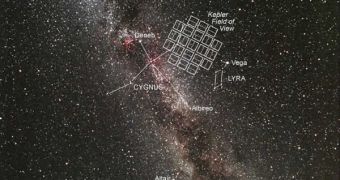The NASA Kepler Space Telescope has identified an additional 833 exoplanetary candidates, bringing the total number of positive detections to 3,538. The announcement was made on November 4, at the second Kepler Science Conference, held at the American space agency's Ames Research Center (ARC), in Moffett Field, California.
Astronomers around the world are gathered at the conference, where NASA scientists are presenting their latest findings related to the exoplanets in Kepler's narrow field of view. From the new sample of candidates, 10 are less than twice the size of Earth, and orbit in their parent stars' habitable zones, where temperatures are just right to support the presence of liquid water on their surface.
This conference takes place just two years after Kepler scientists presented their first confirmed, potentially habitable exoplanet, called Kepler-22b. An additional four such worlds have been identified since, including two that are located in the same star system.
One of the most important things astronomers determined while studying Kepler data is that most stars in our galaxy have at least one planet orbiting them. This significantly increases the chances of one of these worlds exhibiting characteristics closely similar to those of Earth.
In addition to forwarding exoplanetary research, Kepler data were also used to advance the budding field of astroseismology, which deals with studying the interior of stars in a manner similar to that geologists use to probe the interior of the Earth.
“The impact of the Kepler mission results on exoplanet research and stellar astrophysics is illustrated by the attendance of nearly 400 scientists from 30 different countries at the Kepler Science Conference,” says the principal Kepler science investigator at ARC, William Borucki.
“We gather to celebrate and expand our collective success at the opening of a new era of astronomy,” he adds. Kepler studied a narrow portion of the Milky Way for more than 4 years, surveying 150,000 stars once every 30 minutes.
Astronomers are currently analyzing this vast volume of data, looking for signs of potential exoplanets. Once they find the usual telltale signs – such as dips in a star's usual brightness – they use other telescopes, both in space and on Earth, to confirm the existence of yet another exoplanet.
“Stars are the building blocks of the galaxy, driving its evolution and providing safe harbors for planets. To study the stars, one truly explores the galaxy and our place within it,” explains William Chaplin, who holds an appointment as a professor of astrophysics at the University of Birmingham.

 14 DAY TRIAL //
14 DAY TRIAL //